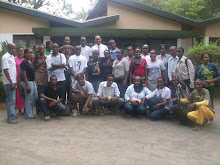Agricultural land is getting scarce as the population grows and the high pressure on land for agricultural production sometimes leads to cleaning of natural vegetation and cultivation on steep slopes.
Soil erosion in these areas is very high. Many farmers also grow crops or keep livestock in a way that deplets the soil nutrients and/or make it prone to erosion.
Practices like removing or burning crop residues, monocropping and allowing animals to graze in cropland are directly destructive. Such practices have left soils bare in many farms, destroyed the soil structure, eroded the topsoil and led to increased problems with weeds, pets and diseases as well as continuous declne of soil fertility.
Sustainable Land Use Management (SLM) practices that include; Use of improved crop varieties that are e.g. fast maturing or more drought tolerant, it is also possible to get good harvests also during short time rainy seasons or unpredictable rain. Use of cover crops that help to reduce soil erosion and keeping the soil moist at the same time as adding nutrients (if nitrogen fixing crops are used), crop rotation and intercropping that help to reduce the weeds and pests on the farm, depresses weeds and keeps the soil moist, Improved tree fallow with nitrogen fixing shrubs is best to use on degraded soils to boost the nutrient content in the soil in order to be able ton grow crops again after the fallow, manure and compost are both bringing back important macro- and micronutrients and improving the soil structure for better water infiltration.
It is also important to improve the fertilizer use effeciency as it reduces the leaching of nutrients to the groundwater as well as it saves money. Through reducing the tilage, the rate of decompostion is slowed down and the soil structure better maintained. Residue management is also a vital for good nutrient recycling o the farm and saves money and nutrients. It also plays an important role for carbon sequestration.
Terracing and other water harvesting structures helps to slow down the water flow so that water infiltrates the soil and erosion of the topsoil is avoided. Agroforestry as an integrated system of trees, crops and animals where the components in the system benefit each other through nutrient recycling, soil and water conservation benefits the farmer and the next farming generation. Rehabilitation is especially important with increasing population pressure in order to keep the degraded land productive instead of leaving it to be wasted.In order to reduce the negative effects from browsing animals, livestock management through e.g. semi/zerograzing is a practice for keeping the animals healthy and enabling the collection of manure.
All these practices together will on the other hand, reduce the prevalence of weeds, pests and diseases, mitigate greenhouse gas emissions as they enable the soil to store more carbon and greatly improve and maintain the capacity of the soil to generate higher yields and improve food and income security of households for many generations to come.
Written by;
Deodatus Kiriba-YET 2011
Subscribe to:
Post Comments (Atom)


No comments:
Post a Comment